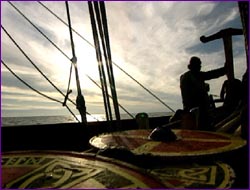
|

|
Secrets of Norse Ships Part 2 | Back to Part 1 The most striking discovery was the biggest longship yet found, 119 feet long, with room for at least 72 oars and a crew of 100. With its draft of only about three feet and a huge, 2,175-square-foot sail, the ship must have been swift and formidable. The excavators speculate that this ship, like the others in Roskilde harbor, may have gone down in a severe storm, then become hidden in silt. Tree-ring analysis of the high-quality oak used for its timbers suggests a construction date of around A.D. 1025.
Did they have other aids? The sagas contain intriguing references to a solarsteinn or 'sunstone' used for navigation. Scholars believe it possible this stone was feldspar, a mineral found in Iceland that polarizes light. Theoretically, a polarizing stone might have helped indicate the direction of the sun when clouds obscured the view. Its practicality is doubtful, however, since it would require some blue sky to work and would thus have proved useless in total overcast.
"The towered ships" The impression that a Viking fleet must have made under full sail can scarcely be imagined today, but a rhapsodizing monk at the monastery of St. Omer, France, tried his best to evoke the sailing of the royal Danish fleet in A.D. 1013: When at length they were all gathered, they went on board the towered ships...On one side lions molded in gold were to be seen on the ships, on the other birds on the tops of the masts indicated by their movements the winds as they blew, or dragons of various kinds poured fire from their nostrils...But why should I now dwell upon the sides of the ships, which were not only painted with ornate colors but were covered with gold and silver figures?...The blue water, smitten by many oars, might be seen foaming far and wide, and the sunlight, cast back in the gleam of metal, spread a double radiance in the air. Evan Hadingham is NOVA's Senior Science Editor. Images: (1-3) © Svergies TV Explore a Viking Village | Who Were the Vikings? Secrets of Norse Ships | The Viking Diaspora Write Your Name in Runes | Build a Tree-Ring Timeline Resources | Transcript | Site Map | The Vikings Home Editor's Picks | Previous Sites | Join Us/E-mail | TV/Web Schedule About NOVA | Teachers | Site Map | Shop | Jobs | Search | To print PBS Online | NOVA Online | WGBH © | Updated November 2000 |

